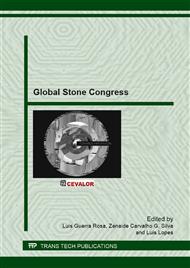[1]
A.D. Moreira, Reconhecimento geológico, estrutural, petrográfico e geoquímico dos granitos de Alpalhão, Gáfete e Quareleiros (Alto Alentejo). Estudos, Notas e Trabalhos 36 (1994) 103-117.
Google Scholar
[2]
M.L. Ribeiro, A. Moreira, M.E. Moreira, M. Moreira, P. Ferreira and L. Torres, Geoquímica das fácies internas do complexo eruptivo de Nisa (NE Alentejo). IV Cong. Nac. Geol. Mem. 4. Fac. Ciên. Mus. Lab. Min. Geol., Porto (1995) 801-804.
Google Scholar
[3]
M. Julivert, J. Fontboté, A. Ribeiro, L. Conde, Memória explicativa del Mapa Tectónico de la Península Ibérica y Baleares (1/1000000). Inst. Geol. Min. España, Madrid (1974) p.133.
Google Scholar
[4]
A.R. Solá, I.S. Williams, A.M.R. Neiva, M.L. Ribeiro, U–Th–Pb SHRIMP ages and oxygen isotope composition of zircon from two contrasting late Variscan granitoids, Nisa-Albuquerque batholith, SW Iberian Massif-Petrologic and regional implications, Lythos 111 (2009).
DOI: 10.1016/j.lithos.2009.03.045
Google Scholar
[5]
A.R. Solá, M. Moreira, M.E. Moreira, M.L. Ribeiro, Relações geoquímicas e magnéticas nas fácies do Complexo Eruptivo de Nisa (NE Alentejo), I Congresso Ibérico de Geoquímica, Sória. Centro de Estudios y Experimentación de Obras Públicas, Spain (1997).
Google Scholar
[6]
A.R. Solá, M.L. Ribeiro, M.E. Moreira, M. Moreira, Complexo Eruptivo de Nisa - Cartografia geoquímica e mecanismo de implantação. Comun. do IGM. V Cong. Nac. de Geologia 84, 1 Lisboa (1998) B-39/42.
Google Scholar
[7]
N. Ferreira, M. Iglésias, F. Noronha, E. Pereira, A. Ribeiro, M.L. Ribeiro, Granitóides da zona Centro-Ibérica e seu enquadramento geodinâmico, in: F. Bea, A. Carmina, J.C. Gonzalo, M.L. Plaza, J.M.L. Rodrigues (Eds. ), Geologia de los granitoides y rocas asociadas del Macizo Hespérico. Libro Homenage a L.C.G. Figueirola. Edit. Rueda, Madrid (1987).
Google Scholar
[8]
L.G. Pereira, A.B.A. Campos, M.L. Ribeiro, A.R. Solá, M. Moreira, Modelo tectónico da implantação do Complexo Eruptivo de Nisa (Alto Alentejo-Portugal). Actas V Cong. Nac. Geologia, Lisboa. Comun. do Inst. Geol. e Mineiro 84 (1) (1998) B11-B14.
Google Scholar
[9]
S.D. Priest and J.A. Hudson, Estimation of discontinuity spacing and trace length using scanline surveys. Int. Journ. Rock Mech. Min. Sci. & Geom. Abstr., 18, (1981) 183-197.
DOI: 10.1016/0148-9062(81)90973-6
Google Scholar
[10]
: ISRM, Suggested Methods for the quantitative description in rock masses. Int. J. Rock Mechanics and Mining Sci. & Geomechanics Abst. 15 (1978) 319-368.
Google Scholar
[11]
E.O. García, Investigacíon de yacimientos, in: C. López Jimeno (Ed. ). Manual de Rocas Ornamentales. Madrid, Entorno Gráfico S.L. (1995) 139-174.
Google Scholar
[12]
P.R. La Pointe, J.A. Hudson, Characterization and interpretation of rock mass joint patterns. Special paper, Geol. Soc. America 199 (1985).
DOI: 10.1130/spe199-p1
Google Scholar
[13]
A. Palmström, The volumetric joint count - a useful and simple measure of the degree of rock jointing. Proc. 4th Int. Cong. Int. Assoc. Eng. Geol. vol. 5. Balkema Publ. (1982) 221-228.
Google Scholar
[14]
A. Palmström, Measurement and characterization of rock mass jointing, in: V.M. Sharma, K.R. Saxema (Eds. ), In-situ characterization of rocks. Balkema Publ. (2001) 49-97.
Google Scholar
[15]
L.M.O. Sousa, Granite fracture índex to check suitability of granite outcrops for quarrying. Engineering Geology, 92 (2007) 146-159.
DOI: 10.1016/j.enggeo.2007.04.001
Google Scholar
[16]
J.V. Lisboa, D. Oliveira, Granitos de Esmolfe e Antas-Matança (Portugal), Petrografia e influência da fracturação no estabelecimento de áreas potenciais para a exploração de granitos ornamentais. Cad. Lab. Xeolóxico de Laxe, Vol. 30, Coruña (2005).
DOI: 10.5380/geo.v52i0.4198
Google Scholar
[17]
A. Casal Moura, Granitos e rochas similares de Portugal, Instituto Geológico e Mineiro, Lisboa, (2000).
Google Scholar


